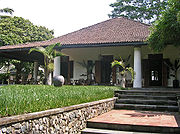
Indo-European house
Encyclopedia

Dutch East Indies
The Dutch East Indies was a Dutch colony that became modern Indonesia following World War II. It was formed from the nationalised colonies of the Dutch East India Company, which came under the administration of the Netherlands government in 1800....
.
They were among the first European colonial buildings in Indonesia to incorporate indigenous architectural elements and attempt adapting to the climate. The basic form, including the longitudinal organisation of spaces and use of joglo and limasan roof structures, was Javanese, but it incorporated European decorative elements such as neo-classical
Neoclassicism
Neoclassicism is the name given to Western movements in the decorative and visual arts, literature, theatre, music, and architecture that draw inspiration from the "classical" art and culture of Ancient Greece or Ancient Rome...
(a European trend of the time) columns around deep verandahs. A predominant feature of the homes, the verandah often had potted palms, cool concrete or marble tiles covered with split bamboo matts and terracotta roof tiles.
Whereas the Indo-European homes were essentially Indonesian houses with European trim, by the early 20th century, the trend was for modernist influences—such as art-deco—being expressed in essentially European buildings with Indonesian trim. Practical measures carried over from the earlier Indo-European hybrids, which responded to the Indonesian climate, Overhanging eaves, larger windows and ventilation in the walls were .
Reference
- Schoppert, P., Damais, S., Java Style, 1997, Didier Millet, Paris, pp.19, 72-77 pages, ISBN 962-593-232-1

